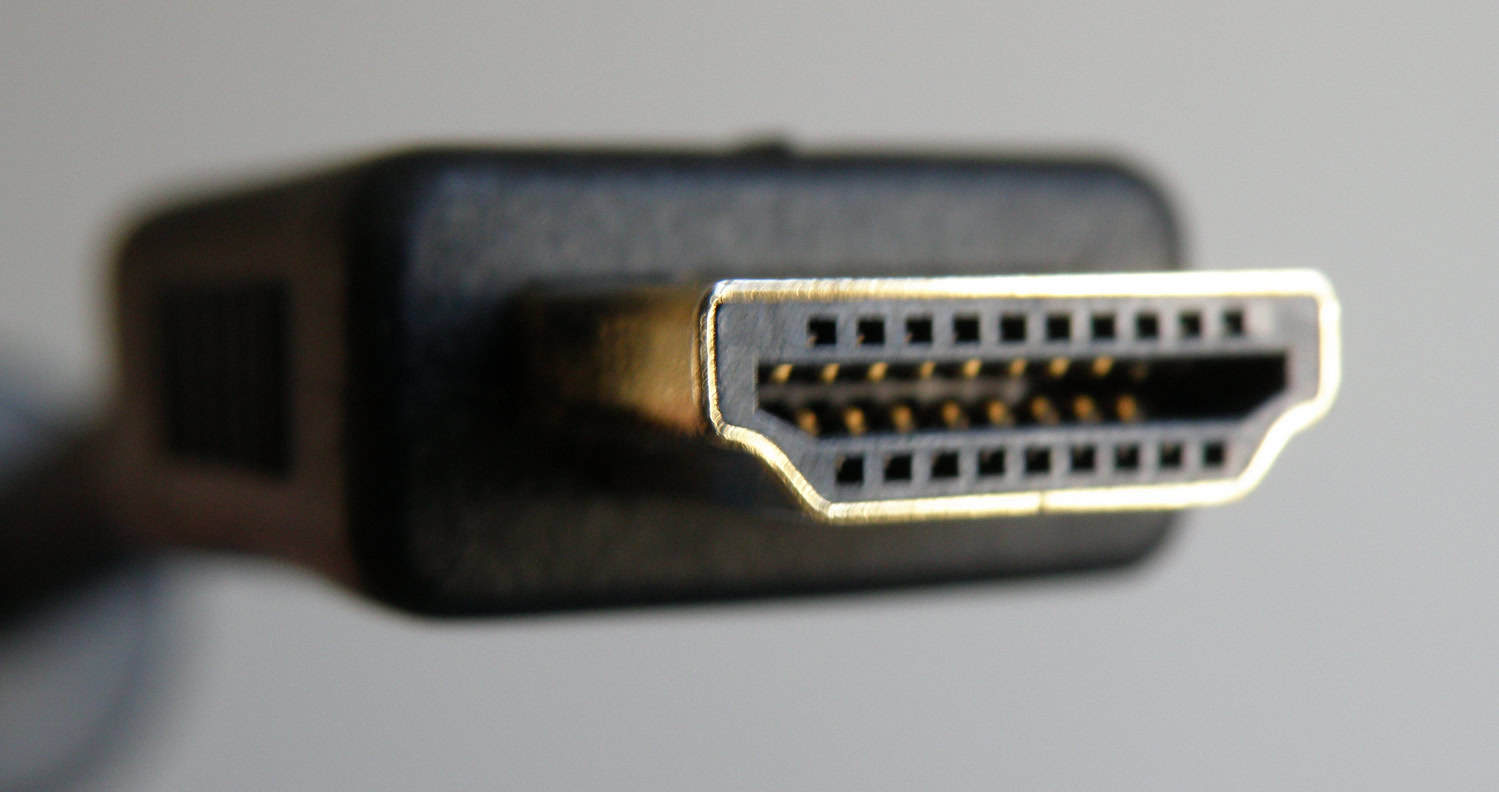Choosing between DisplayPort and HDMI connections can significantly impact your viewing experience, whether you’re setting up a gaming PC, home theater, or professional workstation. Both technologies transfer digital audio and video signals, but they offer different capabilities that might make one more suitable for your specific needs. DisplayPort typically provides higher bandwidth (up to 77.37 Gbps for DisplayPort 2.0 compared to HDMI 2.1’s 42.6 Gbps), allowing for higher refresh rates at 4K resolution (240Hz vs 120Hz) making it generally superior for high-performance gaming and professional applications.
While HDMI has become the standard connection for TVs and home theater equipment, DisplayPort has gained popularity among PC enthusiasts and professionals who require maximum performance. HDMI offers better compatibility with consumer electronics and includes features like Audio Return Channel (ARC) and eARC, which allow sound to travel back from a TV to a sound system with a single cable. The connector you choose ultimately depends on your devices, usage requirements, and future needs.
I’ve already written the introduction for my article about the above. Incorporate your research from above into his. Write the rest of the article. Start with an H2 tag and output in HTML with other header tags (H3, H4) as appropriate so I can copy-paste the final output directly into my article. Make your portion of the article compelling and information-rich with information you’ve derived from sources all over the internet to make my article the single best source on the web. Write in human language and avoid phrases and structures commonly associated with Ai writers. Don’t use citations or reference any sources in the output.
DisplayPort vs HDMI: What You Need to Know
When it comes to choosing between DisplayPort and HDMI in 2025, the differences aren’t just about plug shapes or brand preference—they’re about getting the most out of your monitor, GPU, or entertainment setup. Both standards have evolved dramatically in the past few years, especially with the rise of high refresh rate gaming monitors, 8K displays, and content creators demanding high bandwidth for color-accurate workflows. Here’s how they stack up right now.

D-Kuru, CC BY-SA 3.0 AT https://creativecommons.org/licenses/by-sa/3.0/at/deed.en, via Wikimedia Commons
The Latest Versions: DisplayPort 2.1 vs HDMI 2.1a
As of 2025, the playing field has shifted. HDMI 2.1a is now widely adopted across TVs and gaming consoles, while DisplayPort 2.1 has gained serious ground in the PC space and pro display markets.
| Feature | HDMI 2.1a | DisplayPort 2.1 |
|---|---|---|
| Max Bandwidth | 48 Gbps | 80 Gbps (UHBR20) |
| Max Resolution & Refresh | 10K @ 60Hz, 4K @ 120Hz+ | 16K @ 60Hz, 4K @ 240Hz, 8K @ 85Hz+ |
| Compression Support | DSC (Display Stream Compression) | DSC + Forward Error Correction |
| Audio Return Channel | eARC | No audio return, but supports multi-audio |
| Cable Type | HDMI Type-A (common), Type-C (compact) | DP Standard, Mini DP, USB-C Alt Mode |
| Variable Refresh Rate | Yes (VRR, ALLM, FreeSync) | Yes (VRR, Adaptive Sync, FreeSync, G-Sync) |
| Common Use Cases | TVs, consoles, AV receivers | PC monitors, laptops, GPUs, docking stations |
Gaming: Frame Rates and Latency Matter

hdmi to vga converter adapter, CC BY-SA 3.0 https://creativecommons.org/licenses/by-sa/3.0, via Wikimedia Commons
If you’re into high-refresh-rate gaming at 1440p or 4K, DisplayPort is often the better choice, especially for PC gamers using modern GPUs. DisplayPort 2.1 supports higher refresh rates with less compression—key for competitive gamers.
Why DisplayPort wins for gaming:
- Supports 4K at up to 240Hz without needing DSC on newer monitors.
- Works seamlessly with G-Sync and FreeSync.
- Lower latency and more robust cable locking for fewer signal issues.
That said, HDMI 2.1a is still excellent for console gaming (PS5, Xbox Series X), offering VRR and 4K at 120Hz. Just make sure you’re using an HDMI 2.1-certified cable.
Media and Entertainment: HDMI Takes the Lead in the Living Room
For movies, streaming, and general entertainment—especially on large-screen TVs—HDMI still dominates. It’s better supported by AV receivers, soundbars, and media players.
HDMI 2.1a Benefits:
- Enhanced Audio Return Channel (eARC) for lossless audio passthrough.
- Widespread support across smart TVs and home theater gear.
- Auto Low Latency Mode (ALLM) helps reduce lag for media/gaming hybrid use.
In 2025, most flagship TVs from LG, Samsung, and Sony support full HDMI 2.1a bandwidth, making them perfect for both 4K streaming and next-gen console gaming.
Productivity and Creative Workflows: DisplayPort Excels
If you’re working with high-resolution, high-color-accuracy monitors—especially ultrawide or dual 4K setups—DisplayPort 2.1 is more future-proof.
Key advantages:
- Supports higher resolutions like 8K and even 16K for advanced creative work.
- Multi-stream transport (MST) allows daisy-chaining multiple monitors.
- USB-C Alt Mode with DP 2.1 is popular in laptops and docking stations.
You’ll also find that DisplayPort adapters are more flexible for those working with various display setups (USB-C to DP, MiniDP to DP, etc.).
Cable Differences: What You Plug In Matters
Not all HDMI and DisplayPort cables are created equal. In fact, many users don’t get full performance because of the wrong cable.
Quick Cable Guide:
| Use Case | Recommended Cable Type |
|---|---|
| 4K @ 120Hz via HDMI | Ultra High-Speed HDMI Cable (48 Gbps) |
| 4K @ 240Hz via DisplayPort | DP 2.1 Certified UHBR20 Cable |
| USB-C to 4K DisplayPort | USB4 / Thunderbolt 4 Cable |
| Dual-Monitor Daisy Chain | DisplayPort 1.4+ with MST Support |
Tip: Look for certifications on the cable packaging—generic “high speed” labels aren’t reliable anymore.
Compatibility Notes for 2025
HDMI and DisplayPort aren’t interchangeable. Here’s a look at compatibility based on devices:
- Gaming Consoles (PS5, Xbox Series X) – HDMI 2.1 only
- Modern GPUs (NVIDIA RTX 4000 / AMD RX 7000) – Support both, but DisplayPort 2.1 preferred for higher refresh rates
- TVs – HDMI only
- High-End Monitors – Often support both, but DP 2.1 gives more headroom
- Laptops – Increasingly using USB-C with DisplayPort Alt Mode
So, Which Should You Use?
Rather than asking “which is better,” the real question in 2025 is “which is better for you?” If you’re building a high-end gaming PC or using a pro-level monitor, DisplayPort 2.1 is hard to beat. For living room entertainment or console gaming, HDMI 2.1a offers the widest support.
Knowing your priorities—frame rate, resolution, audio, compatibility—makes all the difference when choosing between them.
Key Takeaways
- DisplayPort delivers higher bandwidth and refresh rates, making it ideal for gaming PCs and professional monitors, while HDMI offers broader compatibility across consumer electronics.
- The latest HDMI 2.1 supports 8K at 60Hz and includes features like eARC for home theater setups, but DisplayPort 2.1 pushes technical boundaries with support for up to 16K resolution.
- Your choice between the two connections should depend on your specific devices, whether you prioritize gaming performance or home theater integration, and how future-proof you want your setup to be.
Fundamentals of DisplayPort and HDMI
DisplayPort and HDMI are the two most common digital interface standards used to connect computers and other devices to displays. Both technologies have evolved significantly over time and employ distinct approaches to transmitting audio and video signals.
Historical Overview
DisplayPort emerged in 2006, developed by VESA (Video Electronics Standards Association) specifically for computer displays and professional applications. The first version delivered a maximum bandwidth of 8.64 Gbps and supported 2560×1600 resolution.
HDMI (High-Definition Multimedia Interface) debuted earlier in 2002, created by a consortium of electronics manufacturers including Sony, Philips, and Toshiba. It was primarily designed for consumer electronics and home entertainment systems.
Both interfaces have gone through multiple iterations. HDMI has progressed from version 1.0 to the current 2.1, while DisplayPort has evolved from 1.0 to 2.1. Each new version has introduced higher bandwidth capabilities, improved resolution support, and additional features.
The development history of these technologies reflects their different target markets – DisplayPort for professional computing and HDMI for consumer entertainment.
Core Technologies and Functions
DisplayPort and HDMI use different technical approaches to transmit data. DisplayPort employs a packet-based protocol similar to PCI Express and USB, making it more flexible for computer applications.
HDMI uses TMDS (Transition Minimized Differential Signaling) technology, which was designed primarily for consumer electronics. This fundamental distinction influences their capabilities and use cases.
Both connectors look somewhat similar but have key differences:
- DisplayPort: Features 20 pins and often includes a physical latch mechanism
- HDMI: Uses 19 pins with no latch mechanism
DisplayPort excels with higher maximum data transfer rates (77.37 Gbps in version 2.1 compared to HDMI 2.1’s 42.6 Gbps). This enables DisplayPort to support higher refresh rates at 4K and 8K resolutions.
Another significant distinction is DisplayPort’s native support for daisy-chaining multiple monitors from a single port, while HDMI requires separate cables for each display.
Physical Characteristics
DisplayPort and HDMI connectors have distinct physical features that affect their use in different devices and setups. Understanding these differences helps users choose the right connection for their specific needs.
Connector Types
DisplayPort features a 20-pin connector that is slightly larger than HDMI. Most DisplayPort cables include a physical latch mechanism that secures the connection and prevents accidental disconnection. This latch provides a more stable connection, particularly valuable in professional environments where cable management is crucial.
HDMI uses a 19-pin connector and comes in three main variations:
- Standard HDMI: The full-sized connector commonly found on TVs, monitors, and gaming consoles
- Mini HDMI: A smaller version used in some tablets and cameras
- Micro HDMI: The smallest variant, typically used in smartphones and compact devices
Unlike DisplayPort, HDMI connectors are asymmetrical, making it easier to identify the correct orientation before insertion. This design helps prevent potential damage from forcing the connector in the wrong way.
Cable Length and Durability
DisplayPort cables generally support longer runs without signal degradation compared to HDMI, especially for higher resolutions. Standard DisplayPort cables reliably transmit signals up to 3 meters, with high-quality cables extending this range to 15 meters without requiring signal boosters.
The latch mechanism on DisplayPort connectors enhances durability but requires more careful handling when disconnecting. Users must press the release button rather than simply pulling the cable out.
HDMI cables are typically rated for reliable performance up to 10 meters at standard resolutions. For 4K content, this distance drops to about 3-5 meters before signal quality issues might appear.
Both cable types offer similar physical durability when properly manufactured. Premium cables often feature gold-plated connectors for improved conductivity and corrosion resistance, along with reinforced cable sheathing for better longevity in high-use situations.
Video and Audio Capabilities
Both DisplayPort and HDMI deliver digital signals for video and audio transmission, but they differ significantly in their capabilities and specifications. These differences can greatly impact performance in gaming, professional work, and entertainment setups.
Resolution and Color Depth
DisplayPort generally offers superior resolution capabilities compared to HDMI in equivalent generations. The latest DisplayPort 2.1 standard supports staggering 8K resolution at 60Hz with HDR, and can even handle 4K at 240Hz. It can drive uncompressed resolution at higher refresh rates than HDMI.
HDMI 2.1, which is the current standard for many new devices, supports 4K at 120Hz and 8K at 60Hz. Earlier versions like HDMI 2.0 max out at 4K 60Hz, while the older HDMI 1.4 handles only up to 4K 30Hz.
For color depth, both technologies support 10-bit color in their recent versions, allowing for over a billion colors. This is crucial for content creators requiring accurate color representation and for HDR content consumption.
The key advantage of DisplayPort is its ability to maintain higher color depths at higher resolutions without compression, making it preferred for professional graphics work.
Refresh Rates and Bandwidth
DisplayPort excels in bandwidth capacity, which directly affects refresh rates and resolution capabilities. DisplayPort 2.1 offers up to 80 Gbps of bandwidth, significantly outpacing HDMI 2.1’s 48 Gbps.
This bandwidth advantage makes DisplayPort the clear winner for:
- Gaming monitors requiring high refresh rates (144Hz, 240Hz, or higher)
- Multi-monitor professional setups
- Applications demanding simultaneous high resolution and high refresh rates
DisplayPort’s higher bandwidth also enables features like Display Stream Compression (DSC), which allows for even higher resolutions and refresh rates without visual quality loss. This is particularly valuable for competitive gamers who need minimal latency.
HDMI remains sufficient for most home entertainment needs at 60Hz, but serious gamers and professionals often gravitate toward DisplayPort for its superior performance at high refresh rates.
HDR Support and Compression
Both interfaces support HDR (High Dynamic Range), but with some implementation differences. HDMI includes HDR support starting with version 2.0a and has become the standard for HDR content delivery in TVs and entertainment systems.
DisplayPort implements HDR through VESA standards and offers more flexibility for HDR parameters. When comparing HDR capabilities:
HDR Implementation:
| Feature | DisplayPort | HDMI |
|---|---|---|
| HDR10 | Supported | Supported |
| Dolby Vision | Limited | Fully Supported |
| HDR10+ | Supported | Supported |
DisplayPort utilizes Display Stream Compression (DSC) to maintain high bit depths at higher resolutions. This visually lossless compression enables 10-bit color at high refresh rates without significant bandwidth penalties.
HDMI also implemented DSC in version 2.1, but DisplayPort’s implementation generally offers more efficiency and higher overall throughput. For professional content creators working with HDR material, DisplayPort often provides more consistent performance.
Version-Specific Features and Performance
Both DisplayPort and HDMI have evolved through multiple versions, each introducing significant improvements in bandwidth, resolution support, and additional features that affect user experience and device compatibility.
DisplayPort Versions
DisplayPort 1.4, released in 2016, offers bandwidth of up to 32.4 Gbps and supports 8K resolution at 60Hz with Display Stream Compression. It introduced HDR metadata transport and enhanced audio capabilities with support for 32 audio channels.
DisplayPort 2.0, finalized in 2019, dramatically increased bandwidth to 80 Gbps, enabling support for three 4K displays at 144Hz simultaneously or a single 16K display at 60Hz with HDR. This version also improved power efficiency and added better support for augmented and virtual reality applications.
The latest DisplayPort 2.1 maintains the same bandwidth as 2.0 but standardizes the physical layer specification for better compatibility. It also includes mandatory support for VESA’s Panel Replay technology, which reduces power consumption in portable devices.
DisplayPort Version Comparison:
| Version | Max Bandwidth | Max Resolution | Notable Features |
|---|---|---|---|
| DP 1.4 | 32.4 Gbps | 8K@60Hz (with DSC) | HDR support, DSC 1.2 |
| DP 2.0 | 80 Gbps | 16K@60Hz | Multiple high-refresh displays |
| DP 2.1 | 80 Gbps | 16K@60Hz | Panel Replay, Standardized PHY |
HDMI Versions
HDMI 2.0, released in 2013, increased bandwidth to 18 Gbps, supporting 4K video at 60Hz and introduced features like dynamic HDR metadata and enhanced audio return channel (eARC). It became the standard for most 4K TVs and monitors for several years.
HDMI 2.1, introduced in 2017, represented a major leap with 48 Gbps bandwidth, enabling 8K resolution at 60Hz and 4K at 120Hz. It added gaming-focused features like Variable Refresh Rate (VRR), Auto Low Latency Mode (ALLM), and Quick Frame Transport (QFT).
Features unique to HDMI 2.1 include eARC for high-bitrate audio formats and Quick Media Switching (QMS) which eliminates the blank screen when switching between video sources. These improvements make HDMI 2.1 particularly valuable for high-end gaming consoles and modern GPUs.
HDMI Version Comparison:
| Version | Max Bandwidth | Max Resolution | Notable Features |
|---|---|---|---|
| HDMI 2.0 | 18 Gbps | 4K@60Hz | HDR, BT.2020 color space |
| HDMI 2.1 | 48 Gbps | 8K@60Hz, 4K@120Hz | VRR, ALLM, eARC, QMS |
Gaming and High-Performance Usage
When choosing between DisplayPort and HDMI for gaming setups, the connection type significantly impacts performance. Each option offers different capabilities for handling variable refresh rates and supporting specialized gaming monitors.
Variable Refresh Rate Technologies
DisplayPort leads the way with superior adaptive sync technologies for smoother gameplay. It was the first to implement variable refresh rate (VRR) through Adaptive-Sync, which became the foundation for AMD’s FreeSync.
HDMI caught up later, with HDMI 2.1 finally adding native VRR support. Before this version, HDMI users experienced more screen tearing and stuttering during gameplay.
For NVIDIA users, G-Sync works best through DisplayPort connections. G-Sync requires specific hardware in compatible monitors to eliminate screen tearing and minimize input lag.
VRR Technology Compatibility:
- DisplayPort: Native Adaptive-Sync, FreeSync, G-Sync
- HDMI: VRR (version 2.1+), FreeSync (limited)
Many professional gamers prefer DisplayPort because it handles these technologies more effectively, especially at higher refresh rates.
Support for Gaming Monitors
Gaming monitors benefit significantly from DisplayPort’s higher bandwidth capabilities. The latest DisplayPort 2.0 delivers 77.37 Gbps compared to HDMI 2.1’s 42.6 Gbps, enabling higher resolutions at faster refresh rates.
This bandwidth advantage becomes crucial for:
- 4K gaming at 240Hz
- Multi-monitor setups
- Ultra-wide gaming monitors
DisplayPort excels in running multiple displays from a single connection, something HDMI cannot match. Gamers who use several monitors simultaneously find DisplayPort the more practical option.
For high refresh rate monitors (144Hz, 240Hz, and beyond), DisplayPort has traditionally been more reliable. Many gaming monitors include both ports, but their DisplayPort connections often support higher refresh rates.
HDMI remains relevant for console gaming, as Xbox and PlayStation systems use HDMI exclusively. PC gamers connecting to TVs also benefit from HDMI’s universal compatibility.
Compatibility and Connectivity
HDMI and DisplayPort offer different connectivity options that affect how users can set up their systems. The choice between these interfaces impacts multi-monitor setups and the adapters needed for various devices.
Multi-Device Support
DisplayPort excels in multi-monitor configurations with its native support for daisy-chaining compatible monitors. This feature allows users to connect several displays through a single port on their computer, reducing cable clutter significantly. A user can connect their PC to one monitor, then run another cable from that monitor to a second display.
HDMI doesn’t support daisy-chaining natively, which means each display requires a direct connection to the source device. For multi-monitor setups using HDMI, users need a source device with multiple HDMI ports or an external splitter.
Thunderbolt, while technically a different standard, can carry DisplayPort signals and supports daisy-chaining up to six devices. This makes it particularly valuable for users with limited ports on their systems.
Adapters and Multi-Stream Transport
DisplayPort offers Multi-Stream Transport (MST), a key technology that allows a single DisplayPort connection to drive multiple independent displays. MST supports connecting multiple monitors through DisplayPort hubs or daisy-chaining compatible monitors.
HDMI doesn’t natively support MST, but users can achieve similar functionality using DisplayPort to HDMI hubs. These adapters require the source device to have a DisplayPort connection.
Adapter compatibility varies between the two standards:
- DisplayPort to HDMI adapters are common and typically work well
- HDMI to DisplayPort conversion is more complicated and often requires active adapters with power
DisplayPort connections are also backward compatible with DVI through adapters, offering flexibility when connecting to older displays. Many modern laptops include Thunderbolt ports that can output DisplayPort signals, enabling connections to various display types through the appropriate adapters.
Specific Use Cases
When choosing between DisplayPort and HDMI, different scenarios call for different connection types. The optimal choice depends on your specific equipment and requirements.
Home Theater Systems
HDMI remains the dominant choice for most home theater applications due to its widespread compatibility with consumer devices. Most TVs, Blu-ray players, and streaming boxes come equipped with HDMI ports as standard.
HDMI’s Audio Return Channel (ARC) and enhanced ARC (eARC) features allow audio to travel both ways through a single cable. This simplifies connections between TVs and soundbars or AV receivers.
For 4K content, HDMI 2.0 provides sufficient bandwidth. Home theater enthusiasts seeking 8K resolution should opt for HDMI 2.1, which supports higher refresh rates and Dynamic HDR.
Consumer Electronics Control (CEC) lets users control multiple HDMI-connected devices with a single remote, creating a more seamless experience in the living room.
HDMI Advantages for Home Theater:
- Universal compatibility with entertainment devices
- ARC/eARC audio functionality
- CEC for simplified control
Professional and Creative Work
DisplayPort excels in professional environments where high-performance computing is essential. For photo editing, video production, and other creative work, DisplayPort’s higher bandwidth and multi-monitor capabilities provide significant advantages.
DisplayPort 1.4 supports 8K resolution at 60Hz with Display Stream Compression, making it ideal for detailed work on high-resolution monitors. The ability to daisy-chain multiple monitors through a single port simplifies desk setups for professionals.
For color-critical work, DisplayPort supports deeper color depths and higher bit rates. This ensures more accurate color reproduction essential for professional photo editing and video production.
Many professional-grade monitors and video cards come with DisplayPort as the primary connection option, acknowledging its superior performance in workstation environments.
DisplayPort Professional Features:
- Higher bandwidth for color-accurate work
- Multi-monitor daisy-chaining
- Better support for high refresh rates at high resolutions
Gaming Consoles and Computer Setups
Gaming presents unique connection challenges depending on the platform. Modern game consoles like the PlayStation 5 and Xbox Series X use HDMI 2.1, supporting 4K gaming at 120Hz with Variable Refresh Rate (VRR).
For desktop PC gaming, DisplayPort often provides advantages with higher refresh rates and Adaptive-Sync technology. Most gaming monitors support both, but DisplayPort typically allows for higher performance ceilings.
G-Sync and FreeSync technologies work best over DisplayPort connections, reducing screen tearing and stuttering during gameplay. These technologies can significantly improve gaming experiences on PC.
Higher refresh rates (144Hz, 240Hz, and beyond) are more readily available through DisplayPort connections, though HDMI 2.1 is closing this gap.
Connection Recommendations by Gaming Platform:
- Console gaming: HDMI 2.1
- PC gaming with high refresh rate: DisplayPort 1.4 or higher
- Multi-monitor PC setup: DisplayPort (supports easier daisy-chaining)
Future-Proofing and Technological Advancements
Both DisplayPort and HDMI technologies continue to evolve with new versions that support higher resolutions and refresh rates. Their development paths reflect different priorities while addressing the growing demands of modern display technologies.
Emerging Trends in Display Technologies
The latest DisplayPort 2.1b specification supports impressive capabilities, handling resolutions up to 16K and refresh rates of 240Hz. This makes it particularly appealing for high-end gaming setups and professional content creation workstations. DisplayPort also integrates well with GPU technologies from manufacturers like NVIDIA and AMD, who often prefer DisplayPort for high-end graphics cards.
HDMI 2.2 introduces the Ultra96 cable standard, designed specifically to handle the increased bandwidth requirements of modern display technologies. This new standard enables support for 10K resolution, making it extremely future-proof for upcoming display innovations.
Both interfaces now support features like:
- Variable refresh rates (VRR)
- Auto low-latency mode
- High dynamic range (HDR)
- Enhanced audio return channel
Long-Term Considerations for Ports and Cables
DisplayPort offers notable advantages with its forward compatible design. The standard allows newer devices to work with older cables in many cases, though maximum performance may require updated cables. This compatibility feature can save consumers money when upgrading individual components rather than entire systems.
HDMI maintains stronger market presence in consumer electronics, particularly in televisions and home theater equipment. Its widespread adoption means manufacturers will likely continue supporting it for years to come.
Cable length also factors into future-proofing decisions. DisplayPort 2.1b has improved its specifications for longer cables, allowing reliable signal transmission over greater distances. This addresses a previous limitation where HDMI held an advantage for longer cable runs.
For professionals requiring multi-monitor setups, DisplayPort’s Multi-Stream Transport (MST) capability remains a significant advantage over HDMI, allowing daisy-chaining of multiple displays from a single port.







